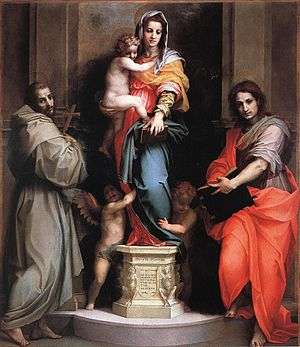Madonna of the Harpies
 | |
| Artist | Andrea del Sarto |
|---|---|
| Year | 1517 |
| Type | oil on wood |
| Dimensions | 208 cm × 178 cm (82 in × 70 in) |
| Location | Galleria degli Uffizi, Florence |
Madonna of the Harpies (Italian: Madonna delle Arpie) is an altarpiece in oils by Andrea del Sarto, a major painter of the High Renaissance. It was commissioned in 1515 and signed and dated by the artist in 1517 in the inscription on the pedestal; it is now in the Uffizi in Florence. It was praised by Vasari, and is arguably the artist's best-known work.
It is a depiction of the Virgin and Child standing on a pedestal which includes harpies sculpted in relief, from which the painting takes its name. They are flanked by putti angels and two saints (Saint Bonaventure or Francis and John the Evangelist). Originally completed in 1517 for the convent of San Francesco dei Macci. The figures have a Leonardo-like aura, with a pyramid shaped composition.[1]
The painting was made for a convent of nuns, and the harpies, figures from pagan mythology, here represent temptation and sin, which the Virgin has conquered and stands upon.[2] The Christ Child is shown as unusually old, and has an athletic contrapposto pose. He looks down to the putti, and all three have a "mischiefness" that contrasts with the serious, abstracted, air of the adults.[3]
The main character in the Kürk Mantolu Madonna ("Madonna With A Fur Coat"), a novel written by Turkish writer Sabahattin Ali, is a depiction of the Virgin Mary in Madonna of the Harpies.
References
- ↑ John T. Paoletti, Gary M. Radke (2005). Art in Renaissance Italy. Laurence King Publishing, ISBN 978-1-85669-439-1
- ↑ Hickson, Sally Anne, Women, Art and Architectural Patronage in Renaissance Mantua, p. 34, google books
- ↑ Franklin, David, Painting in Renaissance Florence, 1500-1550, pp. 136-137 By David Franklin, google books